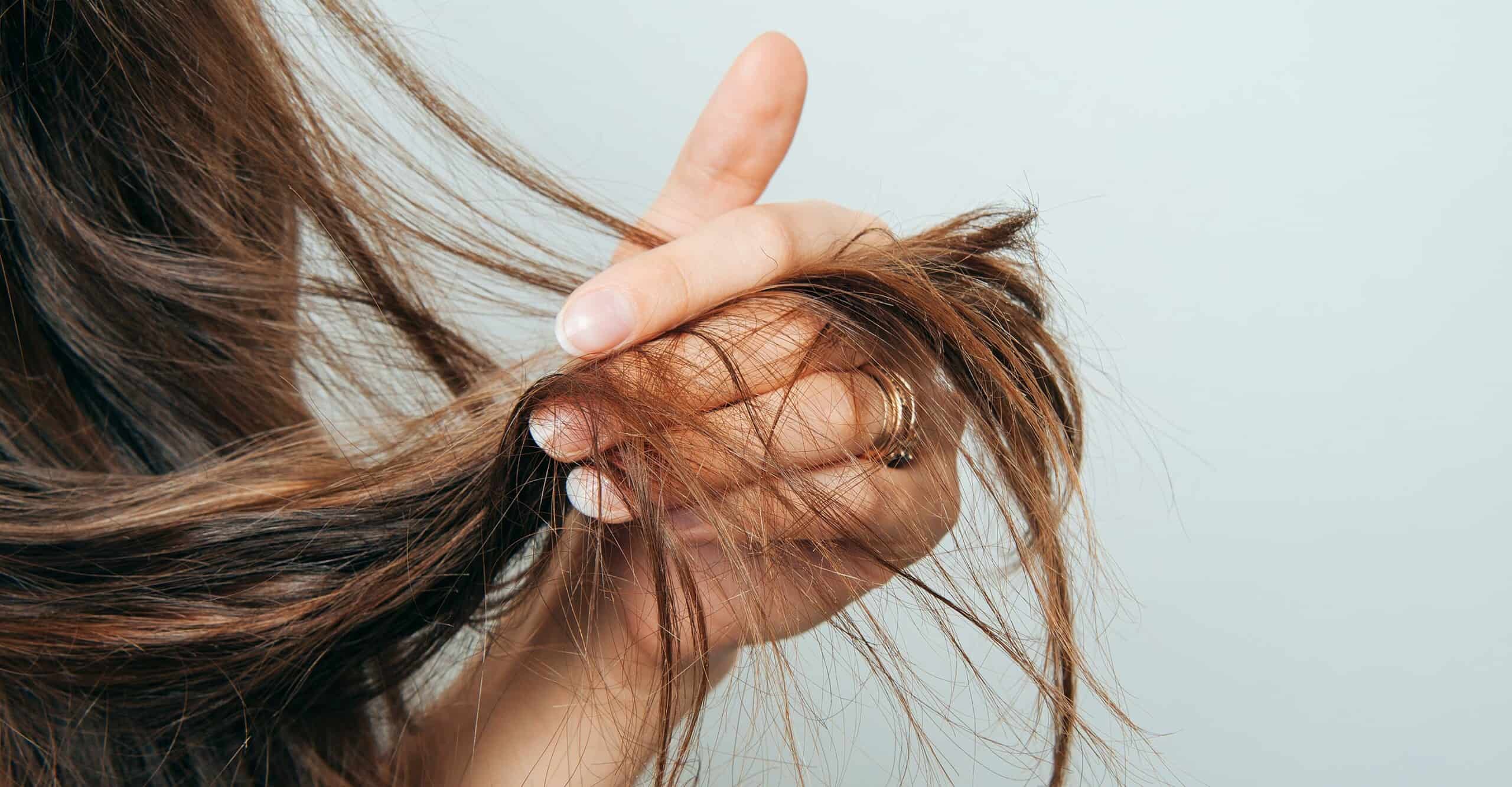How Do Hair Extensions Work?
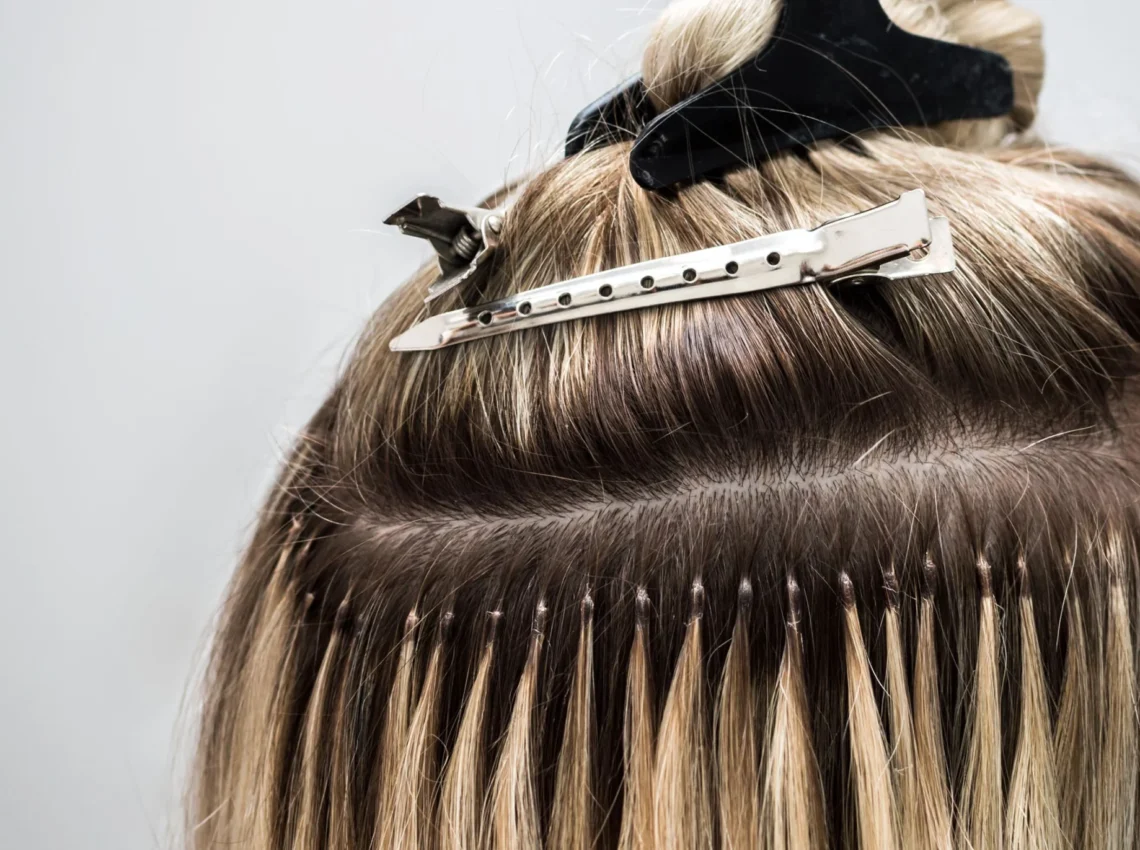
Hair extensions work by blending natural or synthetic wefts in with your existing hair to add length, volume, color, or all of the above. No matter how short or thick your hair is, expertly installed extensions can help you get the look you’re longing for. But just how do some of the most common hair extensions work? It depends, as there are many different extension types with unique attributes.
To help you make the best choice for your hair, we’ve put together this short guide on the most popular extension types. From clip-ins to microlinks, from raw to synthetic, from quick installation to low maintenance — whatever your hair goals, your local hair stylist can make them a reality with extensions that will look phenomenal and perfectly suit your taste.
What is a hair extension?
A hair extension is a piece of either synthetic or human hair that can be attached to your existing hair to give the appearance of fuller, longer hair. Hair extensions come in a variety of textures, colors, and lengths. They can be applied using different application methods depending on the type of hair extension.
How are hair extensions applied?
Hair extensions are perfect for those looking to change up their hairstyle without committing to a definite look. However, it can be overwhelming when deciding on which type of hair extension you want, especially if you have specific requirements that need to be met.
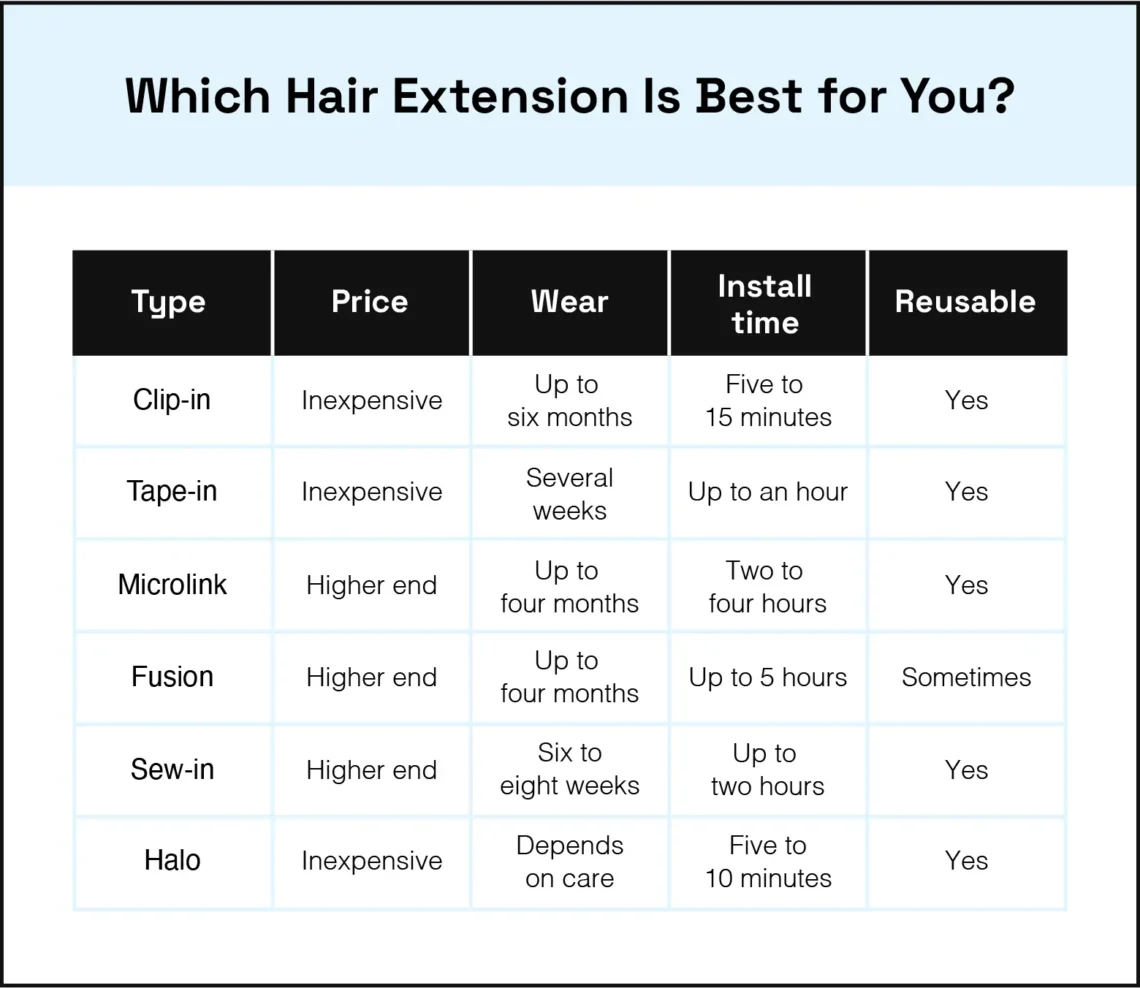
Debating on which hair extension is best for your hair type? Let’s dive into how each type of hair extension works, and the pros and cons of each.
How do clip-in hair extensions work?
Hair extensions have been growing in market popularity and are expected to get even more popular in the coming years. Clip-in hair extensions are partially responsible for that trend due to their simplicity, versatility, and cost.
The name pretty much says it all — the individual hair extension clips clamp right onto your existing hair and can be attached fairly quickly on those days you want to switch your look. You’ll just want to attach them close to the root to keep them secure and well-blended.
This makes them a great choice for anyone looking to try extensions at home or add another style option to their repertoire. They’re also great for anyone with very short hair who wants extensions that are easy to hide.
Installation: Five to 15 minutes to install and can be done from home
Longevity: Can last over six months with regular use
Price: Fairly inexpensive
Reusable: Yes
How do tape-in hair extensions work?
Tape-in hair extensions work somewhat similarly to clip-ins, with a few key differences. A roughly 1-inch strip of adhesive tape secures them to your hair, which may sound easy enough, but should probably be handled by a professional hairstylist. They’re also a little easier on your hair, making them a better choice of extensions for hair that’s damaged or on the thin side.
Installation: Can take up to an hour or more
Longevity: Can stay in for several weeks at a time before needing to be repositioned by your hairstylist
Price: Fairly inexpensive
Reusable: Yes
How do microlink hair extensions work?
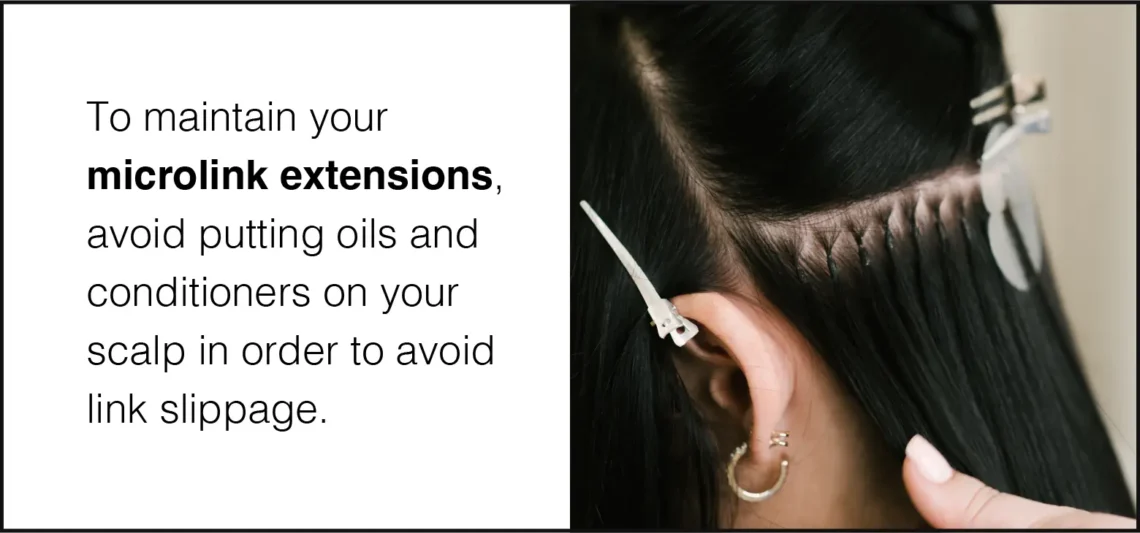
Also known as cold fusion extensions, microlinks are one of the most secure types of hair extensions. To install microlinks, a stylist will secure wefts by threading small batches of your hair through a microbead — a small, usually silicone-lined bead. Once these are clamped in place, the extensions can stay in for several months.
If you want extensions with some real staying power but prefer to steer clear of balms or heat, microlinks could become your extension of choice.
Installation: Can take two to four hours
Longevity: Can last up to four months
Price: Higher end
Reusable: Yes
How do fusion hair extensions work?
In contrast, hot fusion or pre-bonded extensions use keratin glue and a heat clamp to fuse the wefts to your hair. The price of this type of extension falls on the high end since it takes a lot of skill to install safely.
These are essentially a set-and-forget extension type, but you should still stop in to see your stylist for an adjustment every two to three months. Want long-lasting extensions and have thicker hair that makes it tricky to install clip-ins or microlinks? Consider giving this option a try during your next salon visit.
Installation: Can take several hours to install
Longevity: Can last up to four months
Price: Higher end
Reusable: Will depend on level of care
How do sew-in weaves work?
Sew-in hair extensions and weaves are also long-lasting balm and heat-free options for people with certain hair types. The best hair for a sew-in weave depends on your goals and your budget. Raw virgin hair is number one for most, but Remy hair is still high quality while being easier on your wallet.
Your stylist will start by braiding your natural hair into your preferred style, and then they’ll use a needle and thread to sew the extensions into your braids.
Sew-ins are one of the most secure extension types out there. If installed correctly, they can stay in for two months or more before they need an adjustment. Weaves tend to cost more than other extensions, but the look and longevity are well worth it.
Installation: Can take up to two hours
Longevity: Can last six to eight weeks
Price: Higher end
Reusable: Yes
How do halo hair extensions work?
What makes halo hair extensions unique is that they don’t attach directly to your hair at all. These extensions drape down in a semicircle from a round wire that rests over the crown of your head, making them extremely easy to put in and take out at home. All you have to do is cover the wire with portions of your own hair to blend it in, and you’ve got an instant boost in length and volume any time you want it.
Think of halos as a sort of cross between a weave and a wig, combining some of the best features of each. They’re simple to install, require no heat or trips to a salon, and can be seamlessly brushed into your natural hair. And since they need nothing but gravity and a little combing to put in, they can be safer than glue-in or clip-in extensions for hair that’s been damaged or has shown signs of thinning.
Installation: Five to 10 minutes with styling
Longevity: Will depend on level of care
Price: Fairly inexpensive
Reusable: Yes
5 tips for picking the best hair extensions
Picking the best hair extensions starts with understanding what your needs are. There’s no easy choice that will be right for everyone, but we’ve put together a few key considerations below that should help you pick the type that will take your hair to a whole new level.
Remember that some brands may mislabel their hair, so when in doubt, check with your hairstylist for recommendations. They’ve seen the best, the worst, and everything in between, so they’ll be able to steer you in the right direction for your specific hair type and styling needs.
1. Pick Remy hair
What sets Remy hair extensions apart from synthetic or other natural hair is that it’s sourced from donated ponytails whose follicles have been painstakingly preserved. Generally, the source hair has seen minimal to no chemical treatment. These factors combine to create an end product that’s durable, rich, and both looks and feels exceptionally natural.
Remy hair is the highest quality extension available, but it’s also the most expensive and hardest to find. Because of Remy hair’s rigorous quality standards, its availability is highly limited, making it potentially cost-prohibitive or totally unavailable to many people. However, there are several other general hair extension categories outlined below that can fit virtually any budget or styling need.
2. Understand the differences between hair types
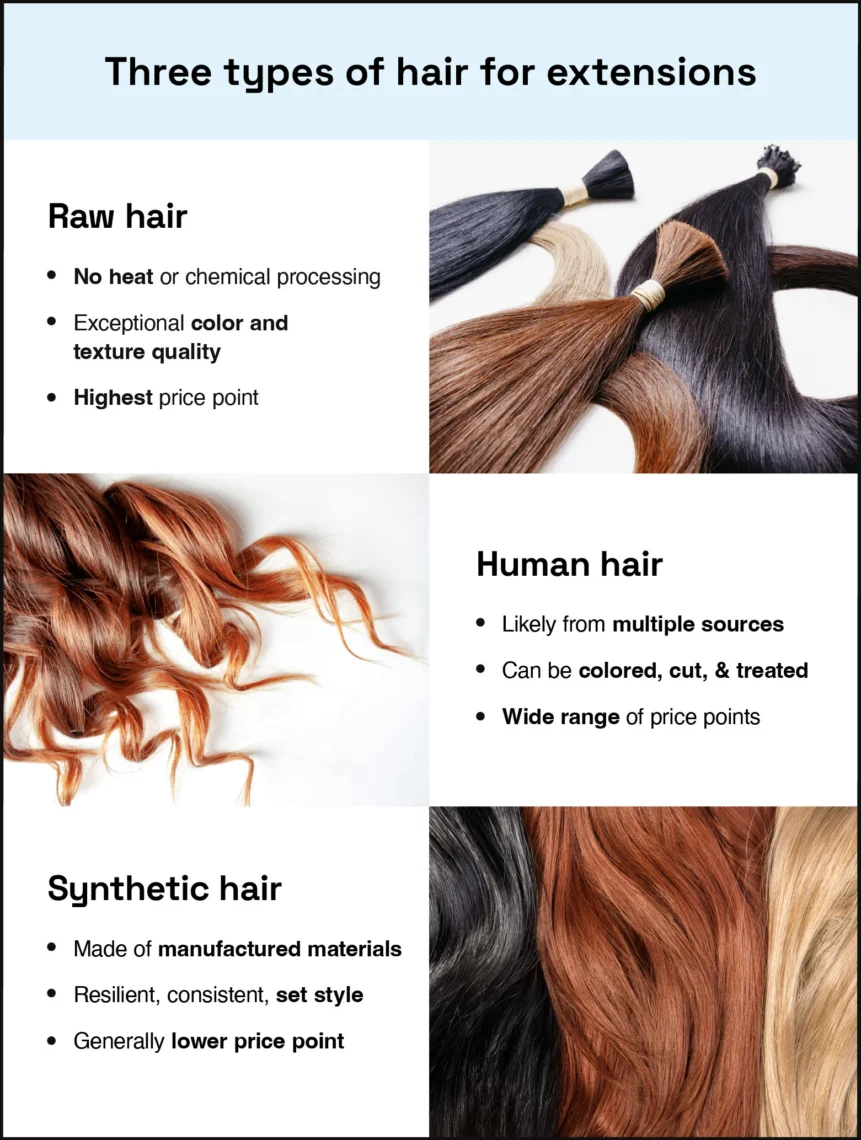
Hair extensions break down into three general categories, each with its own benefits and price points.
- Raw hair extensions are sourced from one donor and are minimally processed, giving them a consistent look and feel with premium quality.
- Human hair extensions include raw extensions, but if they aren’t labeled as raw, then they may come from multiple sources. The price point will be between raw and synthetic for those looking for a balance of value and quality.
- Synthetic hair extensions are made of manufactured materials like nylon. These tend to come at the lowest price point and come in set styles that can’t be heat-treated or dyed. On the other hand, they can maintain their shape and color in any weather condition with minimal upkeep.
3. Know how much hair you need
Are you looking to add a little length, a bump in volume, or a cascade of curls? It might help to find a few styles you love so you can get enough extensions to keep your options open. Remember that it may be relatively easy to have your stylist reduce the length later, but if you want more length or volume, you may need to start from scratch and have them reinstalled.
4. Choose the right color and texture
You’ll want to make sure your extensions match both the color and texture of your natural hair to ensure seamless blending. And while natural hair extensions can be colored and treated, keep in mind that synthetic ones generally cannot.
5. Read reviews on specific types and brands
These days, most of us check the reviews on almost everything we buy. Hair extensions are no exception! Check online reviews to see if customers are noting any red flags, and try to pick brands and lines with generally positive reviews. See if you can find reviews with images, especially from people with a similar hair type as yours.
How much are hair extensions?
The cost of hair extensions varies widely depending on hair type, length, brand, application technique, and the individual salon’s pricing. As anyone who’s overpaid for a brand-name product that’s exactly the same as an off-brand one knows, more expensive does not always equal better quality. It’s always a good idea to check reviews and ask a knowledgeable stylist for advice. Here are a few considerations to keep in mind:
- Human hair extensions tend to cost more than synthetic ones.
- Single-source options like Remy or raw extensions will cost more than multisource ones.
- More temporary methods like clip-ins and tape-ins generally cost less than longer-term methods.
- Longer-lasting options like hot fusion and sew-in extensions tend to be more time-consuming, intricate, and expensive to install.
How to care for your hair extensions
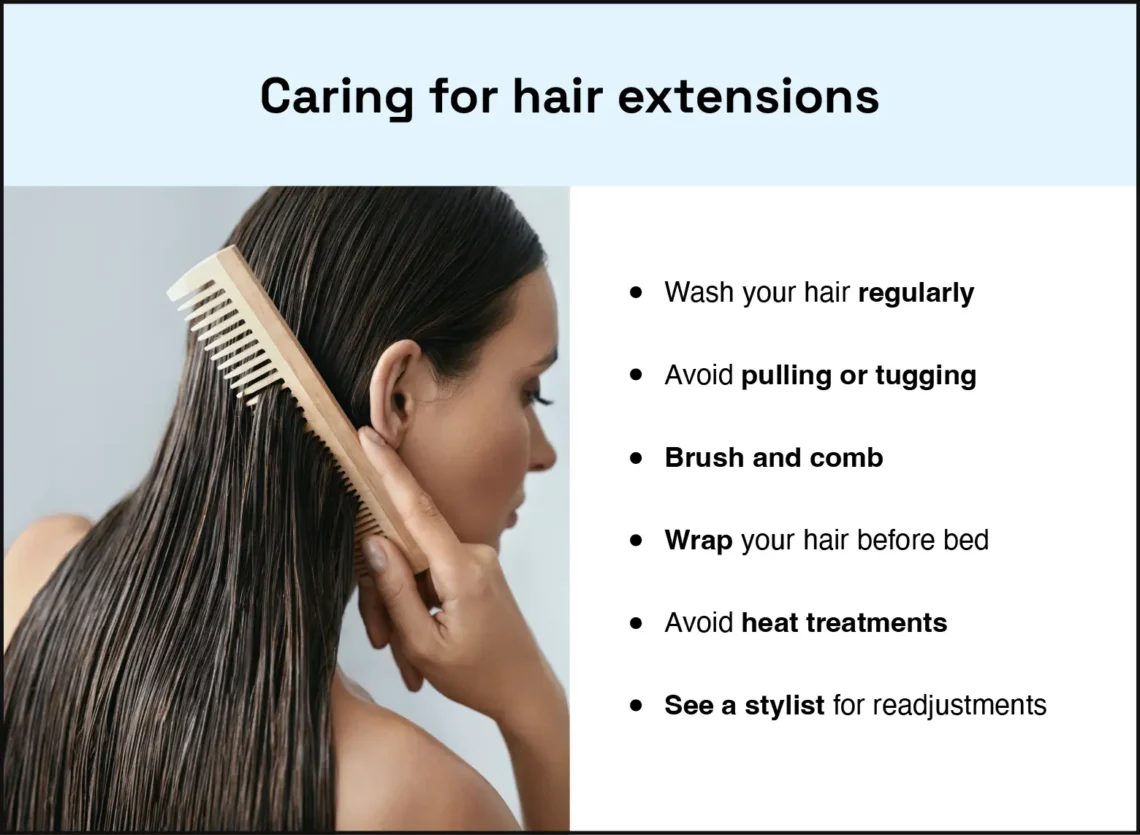
First and foremost, always follow your stylist’s recommendations or, for DIY extensions, the care guidelines on the package. Here are a few other general hair extension maintenance tips to consider:
- Wash your hair regularly, even with the extensions in.
- Avoid any unnecessary pulling or tugging.
- Continue brushing and combing regularly according to texture.
- Wrap your hair in a silk scarf before going to bed.
- Keep heat treatments minimal (or cut them out entirely if the extensions aren’t heat-friendly).
- Have them readjusted by your stylist as needed.
Do hair extensions damage my hair?
Hair extensions shouldn’t cause damage to your hair if they’re installed, cared for, and taken out properly. To make sure your natural locks stay healthy while the extensions are in and well after they’ve been taken out, follow these guidelines:
- Go to a reputable styling professional with experience working with your hair type.
- Don’t leave them in longer than recommended by your stylist or the packaging.
- Have them repositioned at the salon according to your stylist’s recommendations or if they feel uncomfortable at any time.
- Give your natural hair time to recover between installations.
- Continue caring for your hair the way you typically would without extensions.
Hair extension care FAQ
Below we’ve included commonly asked questions about hair extensions and how to choose the best ones for your hair type.
How do hair extensions work for thin hair?
In general, the thinner your hair is, the more susceptible it is to damage. The application processes of some of the more long-term extension types can be taxing on fine locks, so the best extensions for thin hair are the options that apply the least amount of strain.
Halo extensions work phenomenally for thin hair because they don’t need to attach to the roots, meaning there’s no pull and no added weight. Hand-tied and tape-in extensions are also great options if you’d like extensions you can leave in for days at a time.
Are all hair extensions made from human hair?
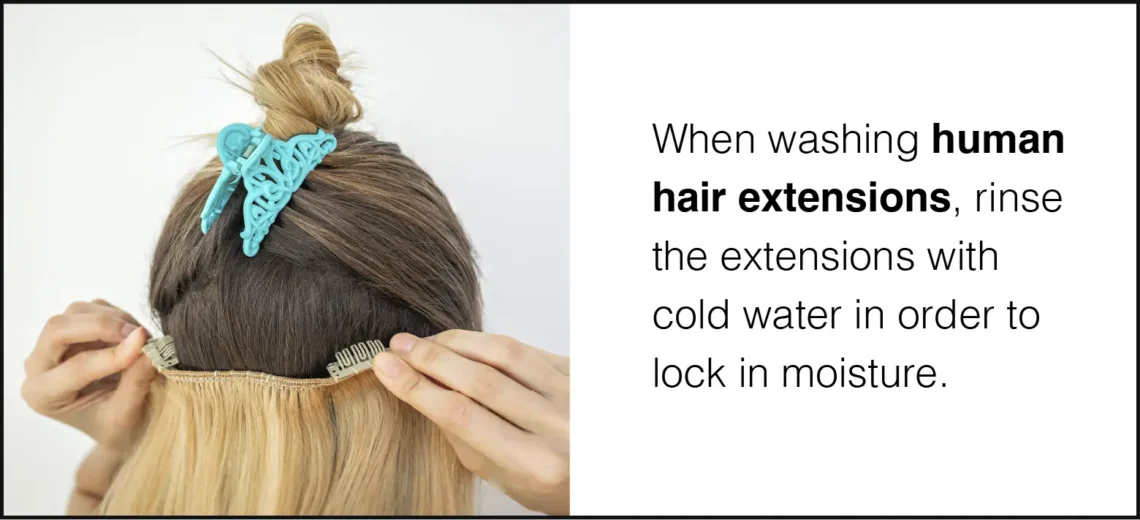
No, not all extensions are made from human hair. Hair extensions can be made of real or synthetic hair, and both have unique advantages to consider. One option isn’t necessarily always a better choice than the other. Some key differences (which we’ll go over more later) include price point, the ability to be colored or heat-treated, and how long they maintain their style.
How often should I change my extensions?
How long hair extensions last depends on the installation method and your lifestyle. If you’re physically active, travel frequently, or spend lots of time outdoors, you may get a little less time out of your extensions due to more unpredictable upkeep or increased wear and tear.
As a general guideline, more temporary types like sew-ins, glue-ins, and tape-ins can stay in place for about one to two months. Meanwhile, clip-ins, microlinks, and hot fusions can stay in place for several months at a time.
The longer you leave yours in, the longer you should let your hair take some time to breathe after you take them out. The strain and weight of extensions may cause damage over time if you don’t care for your hair properly, so it’s important to give your locks some relief from the tension.
Can everyone get extensions?
If you’d like to add that boost in length or volume but are worried your hair is too thin or fragile for extensions, don’t worry! Almost all hair types can work with extensions, but be sure you know which types will work best with your unique locks.
If hair loss and follicle damage are especially concerning for you, then halo extensions could be a viable option. Be sure to talk with a hair stylist before you make your decision. They’ll help you achieve your dream style with the perfect extension type.
Do I need to go to the salon to get hair extensions installed?
Wondering how to get hair extensions? Some types of extensions can be installed at home with a little bit of practice. Clip-ins, halos, and tape-ins are some of the most popular DIY options. If you opt for a home installation, you’ll miss out on the professional customization and expert blending you can only get from a hair stylist.
You’ll also run the risk of damaging your hair if the extensions aren’t installed properly. If you’re not 100 percent confident in your skills, it’s always safer to go with a professional hair stylist. Plus, salon installs offer next-level styling like slow transitions, cuts, dye jobs, and placement.
Do I choose real or synthetic hair extensions?
The biggest factors when choosing between real and synthetic hair extensions are the price points, longevity, and care requirements. Below we’ve listed the biggest decision-makers when it comes to these two types of hair extensions.
Real human hair extensions:
- Cost more than synthetic hair extensions
- Last longer than synthetic hair when properly cared for
- Can be color-treated, although they are usually chemically treated when you purchase them, so you’ll need to take extra care when doing an additional color treatment.
- Requires more styling maintenance, but great for those who like to style with heating tools.
Synthetic hair extensions:
- Cost less than real hair extensions
- Don’t last as long as human hair extensions
- Cannot be color-treated, as it can cause irreparable damage.
- Come pre-set, so no need to worry about your curls falling in a humid climate.
Both real and synthetic hair extensions can seamlessly blend into your hair when properly installed. When deciding which option is best for you, think about how much maintenance you’re willing to put up with and where you plan to wear them. Have a tropical wedding coming up? You may choose synthetic hair extensions for all-day wear. Looking for an everyday natural look? You may opt for real hair extensions instead.
One of our favorite things about extensions is their versatility. Whether you want to dip your toes in with a lower investment option or something more intricate that’ll look amazing for months to come, you’ve got options. Now that you know more about how hair extensions work, you’re ready to reach out to a hair stylist near you to set up an appointment and get a look you’ll love!
